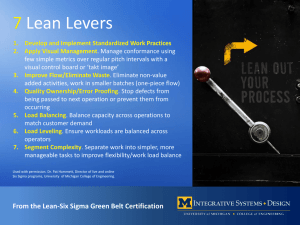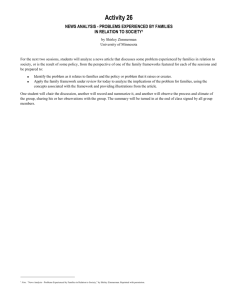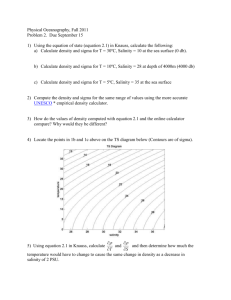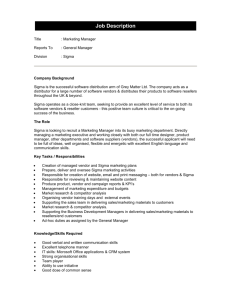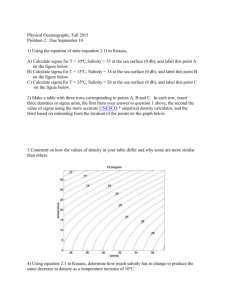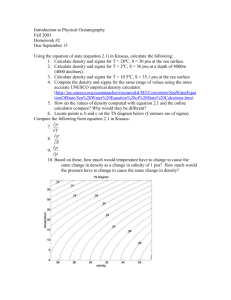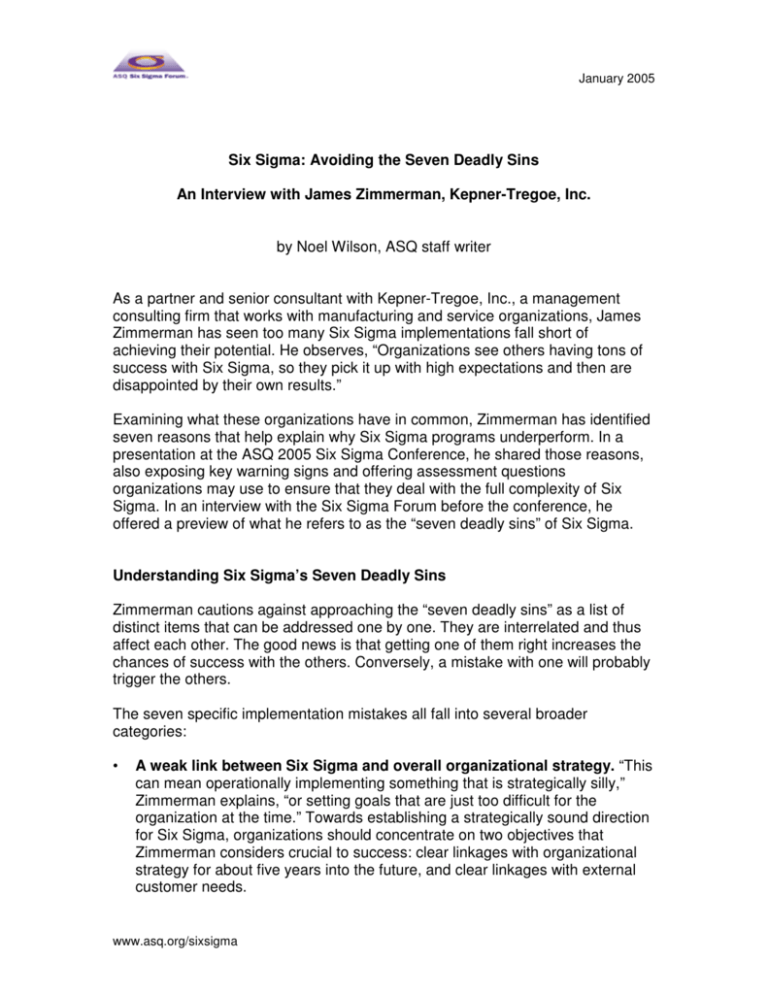
January 2005
Six Sigma: Avoiding the Seven Deadly Sins
An Interview with James Zimmerman, Kepner-Tregoe, Inc.
by Noel Wilson, ASQ staff writer
As a partner and senior consultant with Kepner-Tregoe, Inc., a management
consulting firm that works with manufacturing and service organizations, James
Zimmerman has seen too many Six Sigma implementations fall short of
achieving their potential. He observes, “Organizations see others having tons of
success with Six Sigma, so they pick it up with high expectations and then are
disappointed by their own results.”
Examining what these organizations have in common, Zimmerman has identified
seven reasons that help explain why Six Sigma programs underperform. In a
presentation at the ASQ 2005 Six Sigma Conference, he shared those reasons,
also exposing key warning signs and offering assessment questions
organizations may use to ensure that they deal with the full complexity of Six
Sigma. In an interview with the Six Sigma Forum before the conference, he
offered a preview of what he refers to as the “seven deadly sins” of Six Sigma.
Understanding Six Sigma’s Seven Deadly Sins
Zimmerman cautions against approaching the “seven deadly sins” as a list of
distinct items that can be addressed one by one. They are interrelated and thus
affect each other. The good news is that getting one of them right increases the
chances of success with the others. Conversely, a mistake with one will probably
trigger the others.
The seven specific implementation mistakes all fall into several broader
categories:
•
A weak link between Six Sigma and overall organizational strategy. “This
can mean operationally implementing something that is strategically silly,”
Zimmerman explains, “or setting goals that are just too difficult for the
organization at the time.” Towards establishing a strategically sound direction
for Six Sigma, organizations should concentrate on two objectives that
Zimmerman considers crucial to success: clear linkages with organizational
strategy for about five years into the future, and clear linkages with external
customer needs.
www.asq.org/sixsigma
2
•
Selecting the wrong projects. Too often, Zimmerman states, project owners
select and structure their own projects, pursuing improvements that have
limited organizational impact or that have Black Belt certification as the
primary goal. He recalls learning of a project in a medical products company
to improve the yield of a product manufactured only two days each year. Such
efforts to improve low-margin, low-volume products, he points out, place the
focus on the internal customer instead of the external customer. The end
result amounts to pennies in the grand scheme of the organization’s financial
performance.
•
Inadequate performance management. When a Six Sigma DMAIC (define,
measure, analyze, improve, control) project succeeds, Zimmerman says, the
improvement team tends to receive the recognition; those who conduct the
work affected by the project and contribute to the results are forgotten. “Not
only are they ignored,” he adds, “but even worse, the changes they’re
expected to make aren’t always conducive to their daily work.”
According to Zimmerman, a “feedback disconnect” exists within many Six
Sigma organizations’ performance management systems. The systems
should be incenting participation in Six Sigma, but often the reverse happens.
As an example, he cites a project by one of his clients in the semiconductor
industry. In an attempt to improve workplace safety, the organization wanted
to introduce a measure encouraging staff to report unsafe behaviors of their
coworkers. Admitting that the idea has the potential to produce dramatic
improvements, Zimmerman notes that it could also fail miserably unless
implemented in a thoughtful way.
In fact, Zimmerman judges that all of the “deadly sins” he discusses might be
said to stem from “good ideas not thought through.” Just as a belief in automatic
and instantaneous results can prompt a hastily planned initiative, the influence of
preconceived notions about Six Sigma can prevent organizations from using it
effectively.
For instance, Zimmerman comments on the slow acceptance of Six Sigma
outside of manufacturing: “Part of the Six Sigma baggage is that it’s viewed as a
traditional manufacturing tool, but some of my clients doing their best work are
having their biggest wins on the service side.” His information technology clients,
in particular, have only recently begun to see the need for continuous
improvement. Having sailed through the 90s with plenty of capital and no down
cycles, they have suddenly awakened to the fact that Six Sigma does pertain to
them.
Adhering too closely to conventional Six Sigma wisdom can also cause
organizations to over-apply the methodology, thus prolonging their results.
Zimmerman estimates that only a small percentage, perhaps as low as 5%, of
www.asq.org/sixsigma
3
Six Sigma applications actually require following every single step and using
every single tool. “Judicious application of the right tools would save time and
lead more quickly to the results that organizations are expecting,” he counsels.
The central lesson is, again, to think through the implementation, using the tools
that are required to accomplish the mission.
Taking Corrective Action
The purpose of Zimmerman’s conference presentation is to identify common
implementation mistakes while also suggesting approaches for correcting them.
“Generally, when you find that you’re running into these seven deadly sins, it
doesn’t take a lot of effort to get it right,” he says. Because the training has
already been done and teams are already deployed, corrective action usually
consists of making sure all of the current separate activities are tied together and
tied strategically to the organization.
Arguing that overall success has less to do with the “skills and gumption” of Black
Belts and Green Belts than most would suspect, Zimmerman emphasizes the
responsibility of management to keep the strategic focus of an implementation:
“It’s easy for leaders to whip up the Six Sigma engine and set it into motion. The
real test, however, is whether they provide the structure and ongoing support
necessary for success.”
Zimmerman calls project selection and performance management “the two
mastheads” for that structure and support. He further points out that from the
perspective of the Black Belt or other Six Sigma worker who keeps running into
obstacles presented by an immediate boss, these areas are also the “scariest.”
How their behaviors are rewarded and encouraged will ultimately determine the
progress of the initiative. Zimmerman says, “If leaders tie the right projects to a
performance system that encourages the right behavior over the long haul, much
of the rest will take care of itself.”
For Zimmerman, Six Sigma has already shown itself to be more robust than past
“flavor of the month” initiatives like quality circles and participative leadership.
“When it’s done right, when organizations take a holistic view,” he asserts,
“there’s much more value to be reaped. It can pull billions of dollars in savings.”
The key to achieving that full value lies in remembering the leadership work to be
done between initial project success and sustained results.
Copyright © 2005 American Society for Quality. All rights reserved.
www.asq.org/sixsigma

